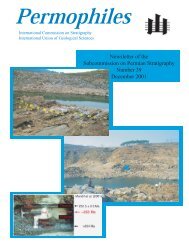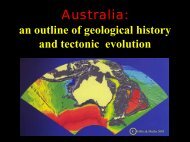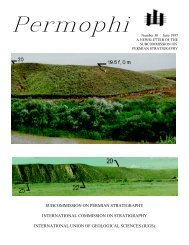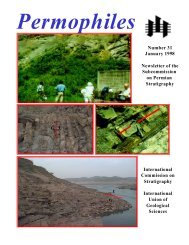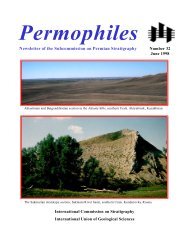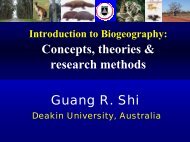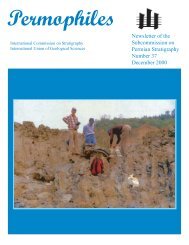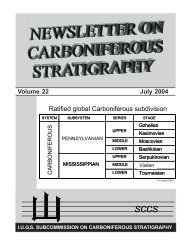Newsletter of the Subcommission on Permian Stratigraphy Number 46
Newsletter of the Subcommission on Permian Stratigraphy Number 46
Newsletter of the Subcommission on Permian Stratigraphy Number 46
You also want an ePaper? Increase the reach of your titles
YUMPU automatically turns print PDFs into web optimized ePapers that Google loves.
Permophiles Issue #<strong>46</strong> December 2005<br />
The base <str<strong>on</strong>g>of</str<strong>on</strong>g> <str<strong>on</strong>g>the</str<strong>on</strong>g> Asselian is dated at about 299 Ma and is schemes. The Kungurian is a tect<strong>on</strong>ically active interval as seen<br />
defined by <str<strong>on</strong>g>the</str<strong>on</strong>g> first appearance datum (FAD) <str<strong>on</strong>g>of</str<strong>on</strong>g> <str<strong>on</strong>g>the</str<strong>on</strong>g> c<strong>on</strong>od<strong>on</strong>t by high subsidence rates in South China (Luodian Secti<strong>on</strong>), uplift<br />
Streptognathodus isolatus in <str<strong>on</strong>g>the</str<strong>on</strong>g> Aidaralash Creek secti<strong>on</strong> <str<strong>on</strong>g>of</str<strong>on</strong>g> and volcanism in <str<strong>on</strong>g>the</str<strong>on</strong>g> Sverdrup Basin, structural inversi<strong>on</strong> in<br />
nor<str<strong>on</strong>g>the</str<strong>on</strong>g>rn Kazakhstan (Davydov et al., 1998). This point is 6.3 Western Canada and restricti<strong>on</strong> <str<strong>on</strong>g>of</str<strong>on</strong>g> <str<strong>on</strong>g>the</str<strong>on</strong>g> Uralian Basin leading, in<br />
metres lower than <str<strong>on</strong>g>the</str<strong>on</strong>g> traditi<strong>on</strong>al boundary that was defined by <str<strong>on</strong>g>the</str<strong>on</strong>g> latter area, to depositi<strong>on</strong> <str<strong>on</strong>g>of</str<strong>on</strong>g> a very shallow marine, evaporite<br />
<str<strong>on</strong>g>the</str<strong>on</strong>g> fusulinacean Sphaeroschwagerina vulgaris. In additi<strong>on</strong>, and c<strong>on</strong>tinental successi<strong>on</strong>.<br />
typical <strong>Permian</strong> amm<strong>on</strong>oids like Svetlanoceras primore occur a The Guadalupian stages are defined in Guadalupe Nati<strong>on</strong>al<br />
little higher, but amm<strong>on</strong>oids are rare and many are endemic to <str<strong>on</strong>g>the</str<strong>on</strong>g> Park <str<strong>on</strong>g>of</str<strong>on</strong>g> <str<strong>on</strong>g>the</str<strong>on</strong>g> Delaware Basin, Texas, USA; this geographic shift for<br />
Urals. The remainder <str<strong>on</strong>g>of</str<strong>on</strong>g> <str<strong>on</strong>g>the</str<strong>on</strong>g> Asselian is correlated using various GSSP definiti<strong>on</strong> occurs because younger <strong>Permian</strong> rocks in <str<strong>on</strong>g>the</str<strong>on</strong>g><br />
species <str<strong>on</strong>g>of</str<strong>on</strong>g> Streptognathodus that are recognized in many regi<strong>on</strong>s, type area <str<strong>on</strong>g>of</str<strong>on</strong>g> Russia are indicative <str<strong>on</strong>g>of</str<strong>on</strong>g> increasingly restricted and<br />
but tax<strong>on</strong>omic issues c<strong>on</strong>tinue to make precise correlati<strong>on</strong> difficult. n<strong>on</strong>-marine c<strong>on</strong>diti<strong>on</strong>s. The Guadalupian stages include <str<strong>on</strong>g>the</str<strong>on</strong>g><br />
The base <str<strong>on</strong>g>of</str<strong>on</strong>g> <str<strong>on</strong>g>the</str<strong>on</strong>g> Sakmarian has not been <str<strong>on</strong>g>of</str<strong>on</strong>g>ficially defined, Roadian defined by <str<strong>on</strong>g>the</str<strong>on</strong>g> FAD <str<strong>on</strong>g>of</str<strong>on</strong>g> Jinog<strong>on</strong>dolella nankingensis,<br />
but Chuvashov et al. (2002a) indicated that c<strong>on</strong>siderable progress <str<strong>on</strong>g>the</str<strong>on</strong>g> Wordian defined by <str<strong>on</strong>g>the</str<strong>on</strong>g> FAD <str<strong>on</strong>g>of</str<strong>on</strong>g> Jinog<strong>on</strong>dolella aserrata, and<br />
has been made. This boundary will be defined by <str<strong>on</strong>g>the</str<strong>on</strong>g> FAD <str<strong>on</strong>g>of</str<strong>on</strong>g> <str<strong>on</strong>g>the</str<strong>on</strong>g> Capitanian defined by <str<strong>on</strong>g>the</str<strong>on</strong>g> FAD <str<strong>on</strong>g>of</str<strong>on</strong>g> Jinog<strong>on</strong>dolella postserrata.<br />
Sweetognathus merrilli at 115 metres about <str<strong>on</strong>g>the</str<strong>on</strong>g> base <str<strong>on</strong>g>of</str<strong>on</strong>g> <str<strong>on</strong>g>the</str<strong>on</strong>g> These species <str<strong>on</strong>g>of</str<strong>on</strong>g> Jinog<strong>on</strong>dolella form a natural<br />
K<strong>on</strong>durosky secti<strong>on</strong> near Orenburg, Russia. The chr<strong>on</strong>omorphocline that can be recognized in West Texas and<br />
chr<strong>on</strong>omorphocline from S. expansus to S. merrilli is well defined South China. However, in many regi<strong>on</strong>s this genus is absent as a<br />
in bed 11. This boundary closely approximates <str<strong>on</strong>g>the</str<strong>on</strong>g> traditi<strong>on</strong>al result <str<strong>on</strong>g>of</str<strong>on</strong>g> significant provincialism, presumably c<strong>on</strong>trolled largely<br />
boundary at <str<strong>on</strong>g>the</str<strong>on</strong>g> introducti<strong>on</strong> <str<strong>on</strong>g>of</str<strong>on</strong>g> <str<strong>on</strong>g>the</str<strong>on</strong>g> fusulinacean Schwagerina by cooler temperature. The base <str<strong>on</strong>g>of</str<strong>on</strong>g> <str<strong>on</strong>g>the</str<strong>on</strong>g> Guadalupian, however,<br />
moelleri and can be correlated into many regi<strong>on</strong>s. Associated can be recognized al<strong>on</strong>g <str<strong>on</strong>g>the</str<strong>on</strong>g> western margin <str<strong>on</strong>g>of</str<strong>on</strong>g> Pangea from <str<strong>on</strong>g>the</str<strong>on</strong>g><br />
c<strong>on</strong>od<strong>on</strong>ts include species <str<strong>on</strong>g>of</str<strong>on</strong>g> Mesog<strong>on</strong>dolella and Phosphoria Basin to <str<strong>on</strong>g>the</str<strong>on</strong>g> Sverdrup Basin by a true geographic<br />
Streptognathodus; <str<strong>on</strong>g>the</str<strong>on</strong>g> former being typical <str<strong>on</strong>g>of</str<strong>on</strong>g> deeper water facies cline <str<strong>on</strong>g>of</str<strong>on</strong>g> Jinog<strong>on</strong>dolella nankingensis nankingensis to J.<br />
or at flooding surfaces in <str<strong>on</strong>g>the</str<strong>on</strong>g> Cisuralian foredeep, but seen <strong>on</strong>ly nankingensis gracilis. In additi<strong>on</strong>, <str<strong>on</strong>g>the</str<strong>on</strong>g> amm<strong>on</strong>oid Waagenoceras<br />
rarely elsewhere at this level. In many areas <str<strong>on</strong>g>of</str<strong>on</strong>g> <str<strong>on</strong>g>the</str<strong>on</strong>g> world highfrequency<br />
is an important marker for Upper Roadian and younger Guadalupian<br />
cyclo<str<strong>on</strong>g>the</str<strong>on</strong>g>ms (typical <str<strong>on</strong>g>of</str<strong>on</strong>g> Upper Pennsylvanian and Lower rocks. A l<strong>on</strong>g reversed polarity z<strong>on</strong>e marks most <str<strong>on</strong>g>of</str<strong>on</strong>g> <str<strong>on</strong>g>the</str<strong>on</strong>g> <strong>Permian</strong><br />
<strong>Permian</strong>) give way to relatively thick, third-order, low frequency below <str<strong>on</strong>g>the</str<strong>on</strong>g> Capitanian, but beginning at <str<strong>on</strong>g>the</str<strong>on</strong>g> base <str<strong>on</strong>g>of</str<strong>on</strong>g> <str<strong>on</strong>g>the</str<strong>on</strong>g> Capitanian,<br />
sequences around <str<strong>on</strong>g>the</str<strong>on</strong>g> mid to upper Sakmarian. This change a regular pattern <str<strong>on</strong>g>of</str<strong>on</strong>g> magnetic reversals occurs. This change in<br />
approximates <str<strong>on</strong>g>the</str<strong>on</strong>g> base <str<strong>on</strong>g>of</str<strong>on</strong>g> <str<strong>on</strong>g>the</str<strong>on</strong>g> Chihsian, which was for a l<strong>on</strong>g time magnetic c<strong>on</strong>diti<strong>on</strong>s is referred to as <str<strong>on</strong>g>the</str<strong>on</strong>g> Illawarra Reversal and<br />
<str<strong>on</strong>g>the</str<strong>on</strong>g> traditi<strong>on</strong>al base <str<strong>on</strong>g>of</str<strong>on</strong>g> <str<strong>on</strong>g>the</str<strong>on</strong>g> <strong>Permian</strong> in China.<br />
should be a valuable correlati<strong>on</strong> tool in <str<strong>on</strong>g>the</str<strong>on</strong>g> n<strong>on</strong>-marine as well; for<br />
The base <str<strong>on</strong>g>of</str<strong>on</strong>g> <str<strong>on</strong>g>the</str<strong>on</strong>g> Artinskian has not been <str<strong>on</strong>g>of</str<strong>on</strong>g>ficially defined, example it is known to occur at <str<strong>on</strong>g>the</str<strong>on</strong>g> base <str<strong>on</strong>g>of</str<strong>on</strong>g> <str<strong>on</strong>g>the</str<strong>on</strong>g> Upper Tatarian <str<strong>on</strong>g>of</str<strong>on</strong>g><br />
but Chuvashov et al. (2002b) indicated that c<strong>on</strong>siderable progress Russia. In fact, <str<strong>on</strong>g>the</str<strong>on</strong>g> Tatarian <str<strong>on</strong>g>of</str<strong>on</strong>g> <str<strong>on</strong>g>the</str<strong>on</strong>g> traditi<strong>on</strong>al Volga regi<strong>on</strong> <str<strong>on</strong>g>of</str<strong>on</strong>g> Russia<br />
has been made. The best secti<strong>on</strong> for a GSSP appears to be Dal’ny largely corresp<strong>on</strong>ds to <str<strong>on</strong>g>the</str<strong>on</strong>g> upper Guadalupian (MIddle <strong>Permian</strong>)<br />
Tulkas near Sterlitamak, Russia at a point marked by <str<strong>on</strong>g>the</str<strong>on</strong>g> FAD <str<strong>on</strong>g>of</str<strong>on</strong>g> and does not serve as a subdivisi<strong>on</strong> <str<strong>on</strong>g>of</str<strong>on</strong>g> <str<strong>on</strong>g>the</str<strong>on</strong>g> Upper <strong>Permian</strong>. The<br />
<str<strong>on</strong>g>the</str<strong>on</strong>g> c<strong>on</strong>od<strong>on</strong>t Sweetognathus whitei within a chr<strong>on</strong>omorphocline Delaware Basin becomes evaporitic at about <str<strong>on</strong>g>the</str<strong>on</strong>g> Guadalupianfrom<br />
S. binodosus. Sweetognathus is usually comm<strong>on</strong> in relatively Lopingian boundary forcing a shift in GSSP definiti<strong>on</strong> to South<br />
shallow water lith<str<strong>on</strong>g>of</str<strong>on</strong>g>acies, but can be correlated with many o<str<strong>on</strong>g>the</str<strong>on</strong>g>r China for <str<strong>on</strong>g>the</str<strong>on</strong>g> Upper <strong>Permian</strong>. These evaporites c<strong>on</strong>stitute <str<strong>on</strong>g>the</str<strong>on</strong>g><br />
regi<strong>on</strong>s. Species <str<strong>on</strong>g>of</str<strong>on</strong>g> Mesog<strong>on</strong>dolella are more abundant in deeper Ochoan, but it too cannot serve as a subdivisi<strong>on</strong> <str<strong>on</strong>g>of</str<strong>on</strong>g> <str<strong>on</strong>g>the</str<strong>on</strong>g> Upper<br />
water lith<str<strong>on</strong>g>of</str<strong>on</strong>g>acies.<br />
<strong>Permian</strong> given <str<strong>on</strong>g>the</str<strong>on</strong>g> relatively short durati<strong>on</strong> <str<strong>on</strong>g>of</str<strong>on</strong>g> depositi<strong>on</strong>.<br />
The base <str<strong>on</strong>g>of</str<strong>on</strong>g> <str<strong>on</strong>g>the</str<strong>on</strong>g> Kungurian has not been <str<strong>on</strong>g>of</str<strong>on</strong>g>ficially defined, The base-Wuchiapingian or base-Lopingian is defined at<br />
but Chuvashov et al. (2002b) indicated that c<strong>on</strong>siderable progress <str<strong>on</strong>g>the</str<strong>on</strong>g> Penglaitan secti<strong>on</strong> near Laibin, Guangxi Province, South China<br />
has been made. The best secti<strong>on</strong> appears to be <str<strong>on</strong>g>the</str<strong>on</strong>g> Metchetlino at <str<strong>on</strong>g>the</str<strong>on</strong>g> FAD <str<strong>on</strong>g>of</str<strong>on</strong>g> Clarkina postbitteri postbitteri in a<br />
secti<strong>on</strong> in Russia at a point marked by <str<strong>on</strong>g>the</str<strong>on</strong>g> FAD <str<strong>on</strong>g>of</str<strong>on</strong>g> chr<strong>on</strong>omorphocline from C. postbitteri h<strong>on</strong>gshuiensis. At <str<strong>on</strong>g>the</str<strong>on</strong>g> type<br />
Neostreptognathodus pnevi within a chr<strong>on</strong>omorphocline from area this boundary occurs within a c<strong>on</strong>formable lowstand<br />
advanced Neostreptognathodus pequopensis. This defining carb<strong>on</strong>ate successi<strong>on</strong> called <str<strong>on</strong>g>the</str<strong>on</strong>g> Laibin Limest<strong>on</strong>e; this point, as<br />
chr<strong>on</strong>omorphocline can also be well recognized from <str<strong>on</strong>g>the</str<strong>on</strong>g> Sverdrup chosen, means that <str<strong>on</strong>g>the</str<strong>on</strong>g> sequence boundary marking this major<br />
Basin <str<strong>on</strong>g>of</str<strong>on</strong>g> <str<strong>on</strong>g>the</str<strong>on</strong>g> Canadian Arctic to <str<strong>on</strong>g>the</str<strong>on</strong>g> Phosphoria Basin <str<strong>on</strong>g>of</str<strong>on</strong>g> sou<str<strong>on</strong>g>the</str<strong>on</strong>g>rn sea-level lowstand can be used to separate <str<strong>on</strong>g>the</str<strong>on</strong>g> Middle and Upper<br />
Idaho, USA. However, <str<strong>on</strong>g>the</str<strong>on</strong>g> defining species is apparently absent <strong>Permian</strong> in many o<str<strong>on</strong>g>the</str<strong>on</strong>g>r regi<strong>on</strong>s where <str<strong>on</strong>g>the</str<strong>on</strong>g> successi<strong>on</strong> is<br />
from <str<strong>on</strong>g>the</str<strong>on</strong>g> Delaware Basin and from South China; in <str<strong>on</strong>g>the</str<strong>on</strong>g>se regi<strong>on</strong>s unc<strong>on</strong>formable. This positi<strong>on</strong> also coincides with <str<strong>on</strong>g>the</str<strong>on</strong>g> first<br />
N. exsculptus may occur somewhat below <str<strong>on</strong>g>the</str<strong>on</strong>g> boundary and a occurrences <str<strong>on</strong>g>of</str<strong>on</strong>g> species <str<strong>on</strong>g>of</str<strong>on</strong>g> <str<strong>on</strong>g>the</str<strong>on</strong>g> fusulinaceans Cod<strong>on</strong><str<strong>on</strong>g>of</str<strong>on</strong>g>usiella and<br />
series <str<strong>on</strong>g>of</str<strong>on</strong>g> Sweetognathus and/or Pseudosweetognathus species Reichelina. The remainder <str<strong>on</strong>g>of</str<strong>on</strong>g> <str<strong>on</strong>g>the</str<strong>on</strong>g> marine Wuchiapingian is<br />
occur above. This is <str<strong>on</strong>g>the</str<strong>on</strong>g> first indicati<strong>on</strong> <str<strong>on</strong>g>of</str<strong>on</strong>g> provincialism that marks correlated by a successi<strong>on</strong> <str<strong>on</strong>g>of</str<strong>on</strong>g> Clarkina species, as is <str<strong>on</strong>g>the</str<strong>on</strong>g> overlying<br />
most <str<strong>on</strong>g>of</str<strong>on</strong>g> <str<strong>on</strong>g>the</str<strong>on</strong>g> rest <str<strong>on</strong>g>of</str<strong>on</strong>g> <str<strong>on</strong>g>the</str<strong>on</strong>g> <strong>Permian</strong> making a single internati<strong>on</strong>al Changhsingian Stage.<br />
standard difficult to apply (Mei and Henders<strong>on</strong>, 2001). There are The base-Changhsingian is defined in Meishan secti<strong>on</strong> D<br />
numerous volcanic ashes within <str<strong>on</strong>g>the</str<strong>on</strong>g> type Cisuralian interval that <str<strong>on</strong>g>of</str<strong>on</strong>g> Changxing County, Zhejiang Province, South China at <str<strong>on</strong>g>the</str<strong>on</strong>g> FAD<br />
will become very valuable for correlati<strong>on</strong> with c<strong>on</strong>tinental deposits <str<strong>on</strong>g>of</str<strong>on</strong>g> Clarkina wangi in a lineage from C. l<strong>on</strong>gicuspidata. Important<br />
(Davydov et al., 2001). The top <str<strong>on</strong>g>of</str<strong>on</strong>g> <str<strong>on</strong>g>the</str<strong>on</strong>g> Kungurian is defined fusulinaceans at this level include species <str<strong>on</strong>g>of</str<strong>on</strong>g> Palae<str<strong>on</strong>g>of</str<strong>on</strong>g>usulina and<br />
differently in <str<strong>on</strong>g>the</str<strong>on</strong>g> internati<strong>on</strong>al scale compared to that in <str<strong>on</strong>g>the</str<strong>on</strong>g> East Colaniella. The boundary occurs during a normal polarity z<strong>on</strong>e.<br />
European Scale seen elsewhere in this issue <str<strong>on</strong>g>of</str<strong>on</strong>g> Permophiles (p. 10, Most <str<strong>on</strong>g>of</str<strong>on</strong>g> <str<strong>on</strong>g>the</str<strong>on</strong>g> Wuchiapingian and Changhsingian z<strong>on</strong>es defined by<br />
11); hopefully, this discrepancy can be corrected so that <str<strong>on</strong>g>the</str<strong>on</strong>g> Clarkina can <strong>on</strong>ly be correlated within <str<strong>on</strong>g>the</str<strong>on</strong>g> “Tethys” whereas in<br />
Kungurian comprises <str<strong>on</strong>g>the</str<strong>on</strong>g> same interval <str<strong>on</strong>g>of</str<strong>on</strong>g> time in <str<strong>on</strong>g>the</str<strong>on</strong>g>se two cool water provinces (Mei and Henders<strong>on</strong>, 2001), l<strong>on</strong>g-ranging<br />
8



